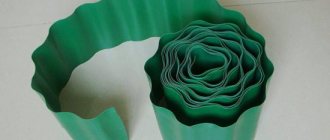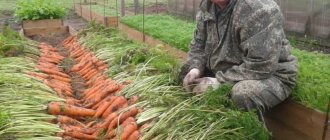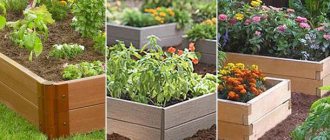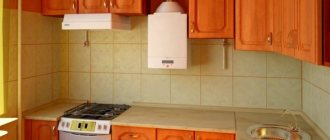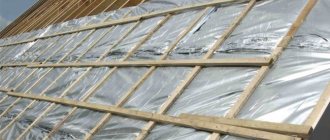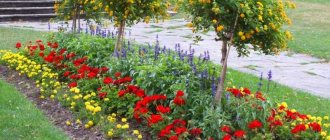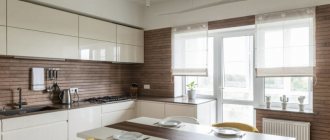How to arrange beds in the garden
Any area loves order. If there is chaos in the garden, if there are adjacent crops that cannot tolerate each other, if the owners do not know what width and height the garden bed should be, then it is unlikely that good fruiting will occur.
It is impossible to simply trust nature and spontaneously arrange ridges, or plant crops at random. Each plant has its own character, it needs its own conditions for growth and development. Therefore, an experienced homestead owner, before planting a particular crop, will find out in what soil the plant will do well and what kind of lighting it needs.
Basic rules for planning beds on the site
Every gardener who has spent decades in his favorite garden knows the requirements:
- it is necessary to plan the site;
- decide where and what cultures will grow, so as not to compete, but to help each other;
- determine the optimal size of beds;
- outline their correct location;
- work out a scheme according to which the plants will be grown.
Layout according to cardinal directions
The most successful layout option is that the beds should go from the north to the south. A location from the southwest to the northeast is also considered a less successful, but quite common option. In the first and second cases, the plants do not lack light; they all have enough warmth and sun, which are so necessary for proper growth.
If the garden is modest in size, then you can deviate from these rules, but you still must not forget that crops still require special attention. So, legumes, cucumbers, and tomatoes prefer the southern side. On the north side you can plant those plants that tolerate cold well. It could be carrots, radishes. However, in any case, the owners of the site need to take care that the north wind does not cause disease and death of plants - they need a good barrier from drafts.
Gardeners often use a green “fence” made of bushes for this purpose. Currants, gooseberries, and raspberry bushes do an excellent job with this task. They protect crops that are afraid of the wind. But it makes no sense to use trees as a barrier from the wind. Not only do they not provide protection, but they also form a shadow curtain, and on the north side there is already little sun.
Taking into account the relief on the site
There is no ideal vegetable garden located on very flat terrain. In any case, gardeners have to take into account the features of the terrain. If you plant seedlings without paying attention to unevenness, you can put an end to a good harvest. What dangers await the garden?
In the lowlands, the snow slowly melts in the spring, the water stagnates, and after the rains, swamp puddles form. Sloping hills are again not suitable, because the plants will experience inconvenience and a lack of light and nutrition.
Therefore, gardeners must level the ground, fill holes and ditches with soil. Areas with a slope are marked so that plants that love moisture can be planted in the lowlands, but drainage still needs to be taken care of. If the garden is located where there is a lot of groundwater, it is better to arrange special mounds for fruit trees using peat, manure, and humus.
Tomatoes, cucumbers, and peppers are usually planted in lowlands, especially in areas where summers are hot. In areas with a cool climate in the lowlands, beds are set aside for zucchini and cabbage.
Sloping terrain is marked, focusing on the cardinal directions. Moreover, it is preferable to plant across rather than lengthwise. This is done so that the plants do not feel thirsty or, on the contrary, do not drown in water.
How to take light into account when creating beds
Another important factor influencing the future harvest is illumination. Plants love light, and if there are trees near the garden bed that cover the area with thick crowns, then the crops will wither. Therefore, you need to try to plan your garden so that all vegetables have enough light.
In addition, you should know which crops love the sun and which prefer partial light. For example, potatoes and peppers need a lot of sun; they are not too afraid of heat. And tomatoes, although they are heat-loving, heat is harmful to them. Zucchini needs long sunny days. Pumpkins, eggplants, melons, and squash enjoy the sun.
But beets need partial shade; this is the most comfortable environment for this crop. Cucumbers also seem to love the sun, but partial shade is also suitable for them. But you should be careful when planting lettuce, cabbage, parsley, and arugula. These crops wither in the sun, they need shade for most of the daylight hours, and only three hours of bright sunlight a day is enough.
Factors for proper plant placement
In order for plant care to be minimal while maintaining and even increasing productivity, the task of how to arrange plants in a summer cottage must take into account and describe a number of factors:
- Natural light, i.e. the amount of ultraviolet radiation received or shade tolerance. Some plants love “sun heating”, while others simply “burn” from the sun’s rays; they feel better in the shade of other plants. There are also those that can grow with virtually no light, for example, onions can grow even in the basement, so they are not afraid of any degree of shading.
- Ventilation or exposure to air currents that provide removal of increased moisture. This is an important point because many plants love moisture but quickly become sick without good air flow. For example, tomatoes love water, but too much water and little ventilation quickly leads to plant depression and disease. The same judgments apply to bushes and trees.
- The slope of the site is an important point that simultaneously participates in the heating of the soil, the circulation of moisture in the soil, and also the lighting of the bed. Almost all plants prefer a slight slope, some prefer flat lowlands, and a number of vegetation simply cannot develop normally without an elevation or hillock. This is how grapes show best results on mountain slopes, when moisture does not linger but quickly disappears.
- Factors on how to place plants on a summer cottage , photo examples of which can be found on the Internet, indicate the chemical composition of the soil and its looseness. Thus, rhizomes develop poorly in heavy, compacted soil, but under such conditions trees, many shrubs and even garden plants with abundant greenery grow well. Soil acidity is the most important factor for the active formation of fruits, and even with sufficient fertilizer content, a shift in the acid-base balance towards harm to the plant variety leads to its inhibition, and sometimes even the impossibility of survival. For example, sorrel, rhubarb, and apple trees love acidified soils, but most vegetables cannot withstand such a chemical composition.
- Soil moisture, more precisely, the ability to retain moisture without the formation of direct stagnation of water. Excess moisture in many plants causes rotting of the root system, but a number of plants have “swamp relatives”, so they thrive on lands with high groundwater levels. A prime example is rice, which is grown in flooded fields.
- Neighborhood or factor, how to arrange plantings on a summer cottage . Each plant removes from the soil the substances necessary for growth, thereby changing the chemical composition of the earth. It is this change that affects some plants negatively, while others have a beneficial effect. This is where the concept of good neighborliness in the garden came from. So the apple tree and pea perfectly complement each other and respond well to such a symbiosis.
It is worth noting that summer residents are mainly concerned about creating suitable conditions for growth in terms of humidity, light, and ventilation, forgetting about the factor of good neighborliness.
What size should the beds be?
Each owner has his own garden size, with its own relief structure, so there are no standard rules for marking out beds and there cannot be. However, everyone comes with markings, taking into account the ease of use of the site.
Bed width
The average width of the planting strip is recommended to be 50 cm, but only if the gardener plans to approach the garden bed only from a specific side. If it is assumed that the work will be carried out from opposite sides, then the ridge may be a meter wide. The gardener will reach with his hand to the middle of the ridge to remove weeds, introduce fertilizing, and carry out watering work.
Ridge height
In regions with cold climates, gardeners try to raise the beds slightly so that the plants are in a comfortable environment, so that the cold from deep in the ground does not cause discomfort to the roots. The height of the bed in such an area is recommended to be 10 cm. It can be made higher. Raised beds are paved on a deck made of boards, you can use plastic or slate.
Track width
Paths that are too narrow are inconvenient to use. A gardener should feel comfortable, and not like a heron on one leg. Therefore, the optimal path width is 40 cm.
Planning crop placement
Determination of soil acidity and adaptation of its composition to the crops grown
To plan planting rationally, it is necessary to study the composition of the soil on the site and find out which plants it is suitable for. It is advisable to determine the acidity of the soil in the laboratory by taking samples from different places on the site. It is also possible to carry out a test at home, but it will not be as accurate: soil samples are poured into a container and a little vinegar is added to them. If bubbles appear on the surface, this indicates a neutral or alkaline soil pH, and a lack of reaction means that the soil is too acidic. Heavy, clayey soil needs to be dug up with sand, peat and black soil. The percentage of additives depends on what crops you intend to grow.
In the photo: Testing soil acidity
How to apply geographical feasibility in planning
When planning beds, you need to take into account the location of the site. On slopes it is best to place transverse beds directed to the south and southeast. In the lowlands, the beds are formed from south to north: this way they warm up faster. On dry soil with deep groundwater, plantings are located from west to east. In this case, the shade from the plants will retain moisture in the soil longer. On a large area, it is advisable to place the vegetable garden in the south, and the orchard in the north. If there are trees on the site, the beds are laid out at some distance from them so that the vegetables do not end up in the shade.
- Yeast solution as a growth stimulator and plant immunity enhancer
In the photo: Building beds in the yard
Creating beds
The number of beds is planned in accordance with the vegetables being planted. Their width should not be more than 1.2 m, but the narrower the beds, the easier it is to care for them - planting, weeding and watering. The row spacing is left 0.5 m wide so that it is convenient to walk between the beds, pick berries and fruits and remove garbage in the fall. The aesthetic appearance of a vegetable garden depends on maintaining clear boundaries between the beds. To prevent the growth of weeds, the passages are sprinkled with gravel or coarse tree bark.
In the photo: Decorating the beds
The bed itself can be edged with a low border of parsley, lettuce or lovage. Borders should not block plants from light. Their goal is to emphasize beauty and save usable space. To enclose the entire garden, a fence is most often used, but it is better to plant fruit and berry or ornamental shrubs instead - barberry, gooseberries, grapes, cotoneaster, lilac or spirea.
Bulk beds
These beds are raised above the soil level, so they warm up faster in the sun. In regions with cool climates, this advantage is especially valuable. It is good to create such beds in places where groundwater lies close to the surface, as well as in areas subject to flooding by melt water in the spring.
It is convenient to grow cucumbers, onions and garlic in high beds - crops that are sensitive to high humidity and are easily affected by root rot.
To create such a bed, you must first mark it out: fence it with pegs and connect these pegs in series with twine. Coarse waste, stems and branches are placed under the bed for drainage, and fertile soil is poured on top.
In the photo: Bulk beds
Raised beds have the following advantages:
- they warm up quickly in the spring, which allows crops to be planted earlier;
- the soil temperature in such beds is always higher, so heat-loving crops can be grown on them;
- the garden bed is set up quickly and is suitable for any vegetables, except moisture-loving cabbage;
- in low-lying areas with regular flooding, high beds are the only way to grow useful plants;
- It is easier to increase soil fertility in high beds.
Bulk beds also have disadvantages: the high cost of imported soil, as well as the rapid drying of the soil in the heat and, therefore, the need for frequent watering. This problem is solved by mulching the surface, but this also requires additional labor and financial costs.
- Covering material: types, features, application
If there is no border, when it rains, water drains from the beds and the soil is washed away.
Box-bed
Having improved the bulk bed, a box is obtained. This is the name of a crop planting fenced with a border. It is not difficult to create a box, but you will need material for its fencing - brick, stone, boards, slate, etc. Organic waste (branches, leaves, tops, humus) is placed at the bottom of the box. Fertile soil is poured onto the drainage layer. When fencing the bed with boards, slate or brick, moisture is retained better, since these materials are not so heated by the sun. The fence does not allow weeds to get inside, and there are fewer of them. It is convenient to work with such beds, and if you constantly loosen the soil, then autumn digging may not be necessary. High-quality beds look good and elegant.
In the photo: Box bed
What shape can the beds take?
There is no friend for the taste and color, or rather, the shape of the garden bed. Because every owner can come up with his own, more convenient for him.
Gardeners usually mark rectangular beds; this is the traditional shape that is used everywhere. However, if the plot does not have the correct shape, but you need to find a place on it for various crops, then you can make a “triangle”, “oval”, or “square” bed. Some gardeners even install multi-level structures, which not only help save space, but also become an original landscape design solution. However, in this case, the owners of the site must choose such a space so that the crops do not lack light.
What kind of sides can be made for the beds?
Some gardeners believe that fencing of this kind is unnecessary trouble. But others argue that this is one of the good ways not only to keep the ridges from crumbling, but also the opportunity to somehow limit the access of weeds.
Experienced gardeners agree with the second statement, and install fences for beds from slate, boards, make a special box, prepare metal, stone or plastic sides.
Each of the materials chosen for the sides has advantages and disadvantages:
- Slate. Since you can use an old one that has already been used for fencing, the benefit is obvious. However, it is believed that this material is inferior in environmental friendliness, for example, to wood, and is fragile and breaks quickly.
- Wooden sides. Making a fence is easy, and the material is inexpensive. However, such sides do not “live” for long; from time to time the beds will have to be made new.
- Metal. The material is quite durable, but it heats up in the sun, which is not very good for the soil, especially in hot weather. For fencing, you should choose metal structures that have been treated against moisture.
- Stone sides. Durable, aesthetic, which decorate the site. However, decorating a garden bed with such material is difficult, and garden beauty will require costs.
- Border tape. The easiest option is to buy the tape in a specialized store. It will last a long time, but a high-quality product is expensive, and getting involved with a cheap one means adding hassle to yourself, including financial ones.
- Plastic. Even simple mineral water or soda bottles, if filled with sand and painted, will become good borders for garden beds. And the design of the site will be original. However, again, according to environmentalists, plastic is not environmentally friendly, like car tires.
How to arrange greenhouses and greenhouses
Greenhouses are temporary shelters for plants, so they do not require a special place. And it is not necessary to place them next to the house, because this design does not need, for example, a heating system, which is often supplied by greenhouses, especially in areas with an unstable climate. It is only important to take into account that it is better to install a greenhouse where it is subsequently planned to grow other crops that require nutritious soil. For example, tomato seedlings.
The greenhouse should be placed where there is sun. It is the sun that will help create the desired atmosphere in this “warm house” for seedlings, so installing such a structure in the shade is pointless and even dangerous. The soil in a greenhouse installed in the shade will warm up very slowly. The location of the greenhouse is preferred from north to south so that the plants inside it receive the right amount of light. Moreover, when planting seedlings, it is important to remember that the northern area should be occupied by tall varieties, and the southern area by low bushes.
How to place tall plants and bushes on the site
Trees do not like cold winds, so on the north side of the site you need to create protection for them so that the plants do not “catch a cold.” By the way, if the trees are located in the north of the site, then they do not provide shade to other plants planted to the south.
Fruit trees are usually planted in two rows. In addition to the north side, the west side is also preferable. Between the rows you need to make gaps of 8 meters, and between the plants themselves, 6 meters is enough.
It is also important to consider that trees should be planted so that neighboring gardens are not affected by their shade, otherwise there will be plenty of problems with other gardeners. Therefore, there should be about four meters between the border of the site and the place where the tree is planted.
The bushes also need to find the right place. Since they do not need bright lighting and can be in the shade, raspberries can be planted near apple trees. Sea buckthorn and chokeberry are not afraid of the wind, so they are often planted instead of a “green fence”. But grapes love the sun and love warmth, so they need to find a place where there is a lot of light.
Plant the bushes so that there is a gap of a meter and a half between them. However, if we are talking about gooseberry bushes, then a distance of 2.5-3 meters should be taken into account, since they are prone to growing. But for honeysuckle and raspberries, as well as currants, a gap of one meter is enough.
Basic rules for creating beds
In order to optimize work in the garden, before starting sowing, you should:
1. Decide what vegetables to grow on the plot and in what quantity.
2. Calculate the required area.
3. Draw up a site plan and the order of the beds.
Thoughtful work will eliminate unnecessary labor costs and even make it possible to allocate a corner for relaxation in a small area.
Length and width of garden beds
EVERYTHING is important! Let's start with this simple truth: both the width and length of the beds. Let's start with the width: the width of the bed should be such that it is convenient to process the plants: planting, weeding, watering and tying up. If you plan to plant potatoes in this place, then the width of the bed should be large, at least 1.5 meters, otherwise you simply will not be able to expand into this area. With a smaller width, it will not be convenient for you to pack and dig the potatoes.
If you plan to grow radishes, beets or radishes, then the bed can be only 40 cm wide (10 cm x row of rows x 20 cm x row of rows x 10 cm). But the optimal width is considered to be the width of the bed, at which you, sitting on a low stool, can calmly, without straining, reach the middle of the bed. This bed width will save your back.
As a rule, with an average human height of 160-175 cm (female, of course), this bed width is only 80 cm! With a bed width of 90-100 cm, you will already have to reach towards its center.
The size of the paths should be no less than 30-40 cm, 40 cm is the optimal size, 30 is the minimum. If you make the path smaller, then you can only walk along it from point A to point B. But the work will be very uncomfortable and cramped, and your back will definitely not thank you.
Well, and finally the length. Preferably no more than 2-3 meters. Running around long beds seems easy just the first time. Very soon you will begin to actively jump over them and not always with success. Not every aged gazelle is capable of jumping over obstacles 10-20 times a day, and with watering cans, hoes and buckets.
Location
You need to start with the correct location of the ridges relative to the sun, landscape, trees and buildings growing on the territory. For a vegetable garden, you need to choose a sunlit area that is not shadowed by trees and buildings all day long. If this is not possible, then at least the area should be illuminated by direct rays of the sun from sunrise to 2-3 o’clock in the afternoon.
It is advisable to place the ridges from east to west, and for tall crops - from north to south. Then the plants will receive light from both sides - the eastern ones before lunch, and the western ones after. The beds should be horizontal so that water does not drain when watering. If the area is uneven, then they are located across the slope or the area is leveled.
Geographical location:
- east-west - for low-growing crops on both sides or for tall crops - from the north, low-growing crops - from the south;
- north-south - for tall plants on both sides.
Dimensions of beds and row spacing
The optimal size of the bed should provide sufficient lighting for the plants and nutrition for the roots. The width of the passage between the beds should be sufficient for convenient processing, taking into account the growth of the crown. Planting parameters largely depend on the crop being grown. For example, for greenery, a traditional 1 m wide bed with 30-40 cm paths is quite suitable. The same configuration can be used for planting climbing plants with the grid positioned along the central axis.
For crops with an abundant crown, such as tomatoes, a meter-long bed with narrow passages is irrational. A more optimal solution would be to narrow it to 90-80 cm, widen the paths to half a meter, and plant the seedlings in a checkerboard pattern.
For root crops, the optimal width of beds and row spacing largely depends on the processing method. For example, potatoes are planted on any shaped piece of land in even rows. Since the crop does not require weeding, tying, or pinching, aisles between the rows are not needed. At the same time, even row spacing of 25-30 cm provides enough space for the development of tubers and is convenient for hilling.
Carrots and beets require more frequent care, so the beds in which they are grown in the garden must be accessible. Considering that the tops of these crops are small, the passages can be made narrow, 30 cm each, and the width of the bed is such that on both sides you can easily reach its middle. On average it is 90-100 cm.
Ridges no wider than 1 m can be covered with film in the spring, since its standard width is 2 m.
With traditional plantings, the width of the beds and row spacing may differ, as it depends on the preferences of the gardener, but in some methods the dimensions are of fundamental importance.
What role does fencing play in the garden?
Many people think that if there is a small fence on the beds, then this is a kind of decoration for the summer cottage. This is a wrong opinion, because this decoration serves to divide the garden. Fencing helps during the construction of greenhouses. Thanks to it, you can care for young plants without any problems.
The border prevents creeping insects from getting into the area where crops are grown, simplifies weeding, and maintains soil fertility. Look how many reasons there are that make it clear that it is worth installing the structure.
When arranging a rock garden, you should take into account the specifics - be sure to arrange drainage and strengthen the base for large stones. The top layer of soil is removed by 25-30 cm. Drainage is arranged from coarse crushed stone or fragments of bricks and construction waste. The soil for planting plants must be depleted so that the plants do not “fatten” and begin to grow wildly, otherwise in a year or two the stones will become very overgrown and will no longer be visible because of the plants. But the highlight of the landscape composition is the stones.
We recommend: How to paint the inside of a bathtub
Advantages and disadvantages
By following all the recommendations and taking into account local characteristics, summer residents grow a crop of vegetables that exceeds the volume of fruiting using traditional methods. Like any idea, this technology has critics and supporters.
Advantages:
- the use of the Mitlider method in the garden in small areas saves space on the plot and increases the harvest volume by 2-3 times compared to conventional farming;
- there will be a good harvest both on fertile and depleted soils;
- weather conditions do not affect the result;
- convenient to care for, easy to approach the ridge from any side;
- high beds can be easily converted into a vegetable garden according to Mittleider;
- 40% less water is required for irrigation than in traditional farming;
- It’s easy to build a greenhouse over the ridges.
Disadvantages of the method:
- gardeners are concerned about a large amount of fertilizers; there is a danger of getting a nitrate crop;
- with constant fertilizing, more moisture is required, which leads to additional costs;
- the cost of fertilizers significantly increases the cost of vegetables.
Recommendations from experienced gardeners and gardeners
Experienced plant growers know all the nuances of working in home gardens. To get a good harvest, you need to adhere to many rules, know the features of crop rotation, and the nature of the crops grown.
Here are some tips from experienced gardeners about plot arrangement:
- It is preferable to use small greenhouses no more than 6 meters long on the site. The fact is that long greenhouses have a “dead” zone in the middle, in which such a steam room is formed that it is difficult for the plants. Therefore, shorter “houses” are much more convenient.
- A greenhouse installed in the north-south direction warms up well in the eastern sun.
- If you install a couple of rows of greenhouses side by side, you can provide a good fence for the area from prying eyes.
- It is best to arrange the trees like chess pieces. The triangular design allows for better care of fruit trees. At the same time, if a gap of 6 meters is needed between tall trees, then three or four are enough between plants of medium height.
- It is advisable to plant cherries on the south side of the site. The same rule applies to plums.
- If they want to grow walnuts on the plot, then they choose a place for it near the house, away from other fruit crops.
- For plums, you need to find a place where there is not a lot of snow. If the tree trunk is covered in snow, this will have a detrimental effect on the plant.
- Currants - white and red - need light, so these bushes cannot be planted where black currants are blissful - in partial shade.
- Strawberries will produce a good harvest only in a well-lit place, closed from drafts.
- Trees that have different periods of ripening and fruiting, but are planted close to each other, feel bad. Winter and summer fruit varieties are not in good harmony, so productivity suffers.
Natalia
Author
Ask a Question
If you approach the planning and arrangement of your garden plot wisely, you can create a favorable environment for crops that will thank the gardener for his care with a good harvest.
↑ Schemes of beds in a greenhouse
↑ In a greenhouse building 240 by 400 cm
In this version, you can make 2 rows on the sides. The width will be 90 cm. Tomatoes, peppers and eggplant varieties can be planted in 2 rows, but cucumber varieties should be placed in a single row. The passage will be 60 cm wide in this case.
↑ Scheme of beds in a greenhouse 300 by 400 cm
A fairly convenient, compact option that allows you to grow many types of plants. You need to follow some recommendations:
- crops should be well lit and have normal access to air;
- the beds are placed along the walls of the structure facing west;
- The width of the beds is 45 cm, and the location is 40 cm above the passage itself.
If in this case the layout of two beds is used, then rows a meter wide can be arranged along the length of the two walls close to them. Leave the rest of the space for passage.
You can plant crops like a chessboard. This method is best used for bush plants.
So, in a greenhouse building with dimensions of 300 by 400 cm, you can successfully plant about 50 representatives of different crops. This is best applicable for low-growing species (melon, pumpkin varieties, watermelons).
If tall varieties are going to be grown in a structure of this size, then it is worth making three rows, so the space will be best used.
Here are a few more possible layouts:
- You can expand the beds due to passages. Use a planting plan based on the checkerboard principle or a square-nested option on the sides and a row in the center.
- We reduce the width of the side beds and make the central one wider. Along the perimeter we plant varieties in a single row, and in the one in the center we plant 2. This makes caring for the crops more comfortable.
If the passages are determined to be 30 cm, then about 25 bushes can be placed in one bed.
↑ Scheme of beds in a greenhouse 300 by 600 cm
This option involves growing a large number of plants, but at the same time it takes up a lot of space on the territory. The frame system for building such a greenhouse consists of profile pipes. The walls are erected from polycarbonate, or glass, or polyethylene, or spunbond.
These sizes allow you to place shelving, which makes it possible to grow even more crops. Arrange the space as follows:
- two beds with sufficient width are placed along the walls;
- Shelving is placed close to the walls in free areas;
- A wooden box is installed in the middle, which can be used to store tools or as a landing container.
If it is necessary to place a bed in the central part of the greenhouse structure, then it should be made as wide as possible. Passages will be placed on the sides, which will provide free access to the plants.

